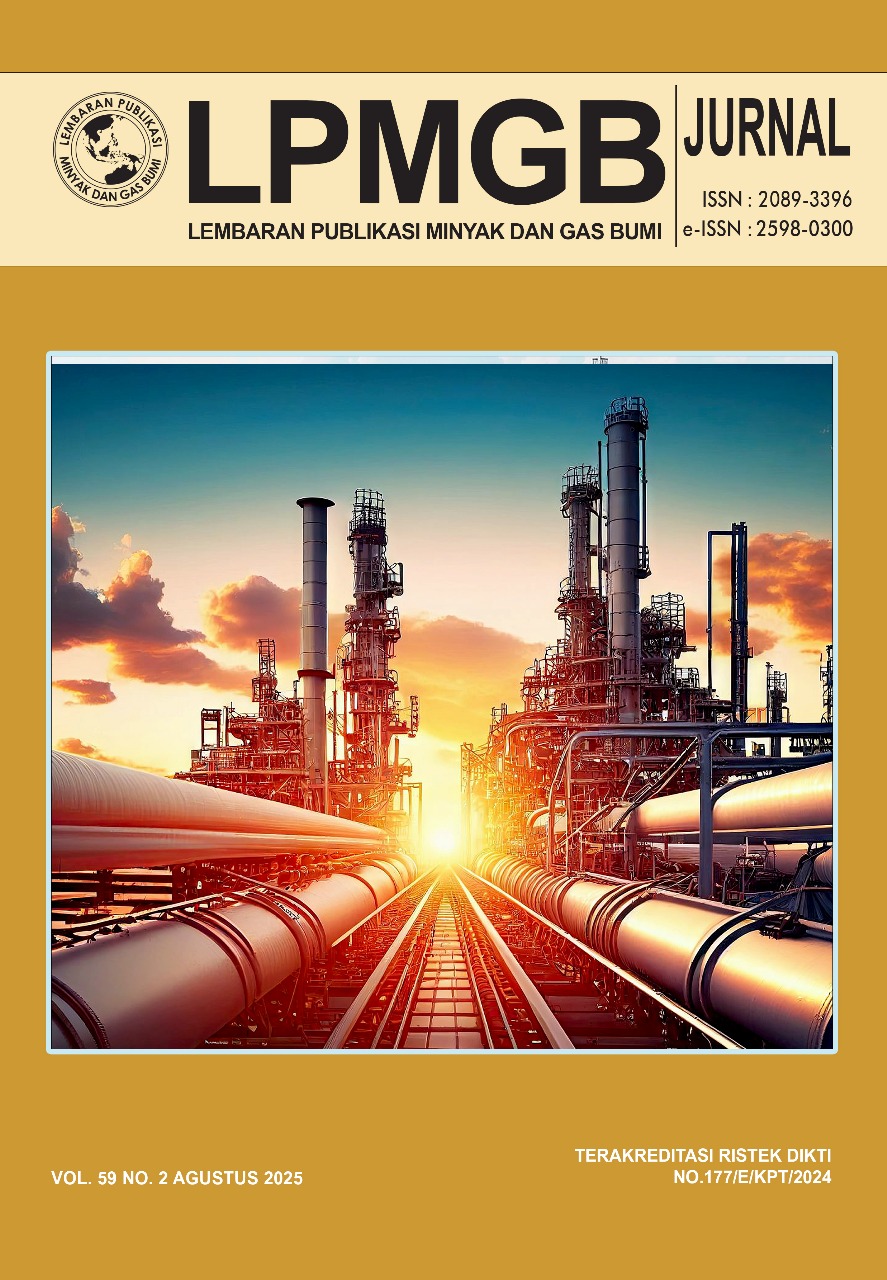Potensi Mineral Silika Pulau Rupat sebagai Proppant Alami Berdasarkan Kriteria API 19C
DOI:
https://doi.org/10.29017/LPMGB.59.2.1810Kata Kunci:
Proppant, Silica, Rupat, API 19C, epoxyAbstrak
Penelitian ini mengevaluasi kelayakan mineral silika dari Pulau Rupat, Riau, sebagai kandidat proppant alami untuk aplikasi hydraulic fracturing, berdasarkan spesifikasi API RP19C. Pengujian melibatkan tiga sampel, yaitu mineral silika Pulau Rupat tanpa modifikasi, mineral silika Pulau Rupat coated resin 5 %, dan mineral silika Pulau Rupat coated resin 10 %. Karakteristik utama yang diuji meliputi roundness dan sphericity, bulk density, turbidity, acid solubility, dan crush resistance. Hasil penelitian menunjukkan bahwa roundness dan sphericity meningkat secara signifikan dengan coated resin, di mana sampel coated 10 % mencapai nilai 0,7 dan memenuhi batas minimum API (>0,6). Semua sampel memiliki nilai bulk density di atas standar minimum API (>1,5 gr/cc), yakni masing-masing 1,53 gr/cc, 1,58 gr/cc, dan 1,60 gr/cc. Nilai turbidity semua sampel juga tergolong rendah, berada pada rentang 20–38 NTU, jauh di bawah batas maksimum 250 NTU. Acid solubility menurun seiring peningkatan fraksi resin, dari 2,8% (tanpa coating) menjadi 2 % dan 1,2 %, memenuhi ambang batas <3 % sesuai API. Pada uji crush resistance seluruh sampel menunjukkan tingkat kerusakan yang dapat diterima, yaitu 6,7 % pada 2000 psi untuk mineral silika pulau Rupat, serta 9 % dan 8 % pada 6000 psi untuk resin coated mineral silia Pulau Rupat, dengan batas maksimum <10 %.
Referensi
API. (2018). Measurement of and Specifications for Proppant Used in Hydarulic Fracturing and Gravel-packing Operations (2nd ed.).
Chen, B., Barboza, B. R., Sun, Y., Bai, J., Thomas, H. R., Dutko, M., Cottrel, M., & Li, C. (2022). A Review of Hydraulic Fracturing Simulation. In Archives of Computational Methods in Engineering (Vol. 29). Springer Netherlands. https://doi.org/10.1007/s11831-021-09653-z
Chen, T., Gao, J., Zhao, Y., Liang, T., Hu, G., & Han, X. (2022). Progress of Polymer Application in Coated Proppant and Ultra-Low Density Proppant. Polymers, 14(24). https://doi.org/10.3390/polym14245534
Economides, M. J., & Nolte, K. G. (1989). Reservoir Stimulation (2nd ed.). Schlumberger Educational Services.
Effendi, D., & Firdaus, A. N. (2023). Penggunaan Pasir Proppant Sebagai Media Hydraulic Fracturing Menggunakan Standar Api - Rp 19C. Journal of Applied Science, 4(2), 1–11.
Fadl, A., & Abdou, M. (2019). Proppants Categories for Hydraulic Fracturing Process of Petroleum Wells: A Review. Global Journal of Engineering Sciences, 2(2), 1–2. https://doi.org/10.33552/gjes.2019.02.000532
Gidley, J. L., Penny, G. S., & McDaniel, R. R. (1995). Effect of proppant failure and fines migration on conductivity of propped fractures. SPE Production & Facilities, 10(1), 20–25. https://doi.org/10.2118/24008-pa
Liang, F., Sayed, M., Al-Muntasheri, G. A., Chang, F. F., & Li, L. (2016). A comprehensive review on proppant technologies. Petroleum, 2(1), 26–39. https://doi.org/10.1016/j.petlm.2015.11.001
Ngwe, T., Swe, M. M., & Than, M. (2019). Review of the Proppant Selection for Hydraulic Fracturing. International Journal of Science and Engineering Applications, 8(9), 418–422. https://doi.org/10.7753/ijsea0809.1003
Novrianti, N., Rita, N., Prayitno, B., Faruq, M., & Arif, I. (2025). Characterization of Resin-Coated Silica Sand from Tibawan Rokan Hulu for Potential Use as A Proppant. Scientific Contributions Oil and Gas, 48(2). 293–312. https://doi.org/10.29017/scog.v48i2.1767
Rahayu, T. S., Kartini, R., Adhitya, D. C., Rahalintar, P., Rosiani, D., & Satria, A. R. I. (2024). SCREENING PASIR ALAM SEBAGAI PROPPANT BERDASARKAN STANDART API RP19C. LEMBARAN PUBLIKASI MINYAK DAN GAS BUMI (LPMGB), 58(3), 147-161. https://doi.org/10.29017/LPMGB.58.3.1698
Ramazanov, V., Matovu, S., Shafloot, T. Al, & Alarifi, S. A. (2025). Enhancing Fracturing Proppant Performance: Methods and Assessment. Arabian Journal for Science and Engineering, 50, 4477–4503. https://doi.org/10.1007/s13369-024-09679-y
Sahai, R., & Moghanloo, R. G. (2019). Proppant Transport in Complex Fracture Networks - A Review. Journal of Petroleum Science and Engineering, 182, 106199. https://doi.org/10.1016/j.petrol.2019.106199
Wang, G., Ma, Q., Ren, L., & Hou, J. (2024). A Comprehensive Review of Multifunctional Proppants. ACS Omega. https://doi.org/10.1021/acsomega.4c06941
Wei, X., Wang, Y., Yang, T., & Song, Y. (2023). A Study on a New Type of High-Performance Resin-Coated Sand for Petroleum Fracturing Proppants. Coatings, 13(11). https://doi.org/10.3390/coatings13111841
Yu, J., Wang, J., Wang, S., Li, Y., Singh, A., Rijken, P., & Elsworth, D. (2022). Conductivity Evolution in Propped Fractures During Reservoir Drawdown. Rock Mechanics and Rock Engineering, 55(6), 3583–3597. https://doi.org/10.1007/s00603-022-02796-w
Zoveidavianpoor, M., & Gharibi, A. (2015). Application of polymers for coating of proppant in hydraulic fracturing of subterraneous formations: A comprehensive review. Journal of Natural Gas Science and Engineering, 24, 197–209. https://doi.org/10.1016/j.jngse.2015.03.024
Unduhan
Diterbitkan
Terbitan
Bagian
Lisensi
Hak Cipta (c) 2025 © Copyright by Authors. Published by LEMIGAS

Artikel ini berlisensiCreative Commons Attribution-ShareAlike 4.0 International License.











